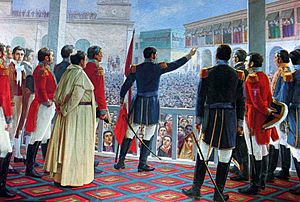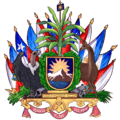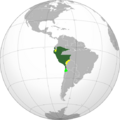Protectorate of Peru facts for kids
Quick facts for kids
Protectorate of Peru
Protectorado del Perú
|
|||||||||
|---|---|---|---|---|---|---|---|---|---|
| 1821–1822 | |||||||||
|
Anthem: National Anthem of Peru
|
|||||||||

Protectorate of Peru
Territories controlled and administered Territorial claims |
|||||||||
| Capital | Lima | ||||||||
| Common languages | Spanish | ||||||||
| Religion | Roman Catholic | ||||||||
| Demonym(s) | Peruvian | ||||||||
| Government | Protectorate of the United Provinces of the Río de la Plata | ||||||||
| Protector of Peru | |||||||||
|
• July 28, 1821 – September 20, 1822
|
José de San Martín | ||||||||
| Historical era | 19th century | ||||||||
| July 28, 1821 | |||||||||
| July 26, 1822 | |||||||||
| ISO 3166 code | PE | ||||||||
|
|||||||||
The Protectorate of Peru (Protectorado del Perú) was a special government created in 1821 in what is now Peru. It was formed after Peru declared its independence from the Spanish Empire. This government lasted for about one year and 17 days. It was led by José de San Martín and supported by Argentina.
Contents
Peru's Fight for Freedom
The Peruvian War of Independence was a series of battles in Peru. It started around 1811 and ended in 1826. This war was about Peru becoming free from Spanish rule.
Peru had been a strong base for the Spanish, known as "royalists." They fought against freedom fighters in Peru and neighboring countries. A very important moment was when José de San Martín declared Peru's independence on July 28, 1821.
How Peru Became Free
Spain's power weakened during a war in Europe (1807–1814). This allowed many regions in South America to start their own local governments. Peru, however, remained loyal to Spain for a long time.
Early attempts to gain independence in Peru came from different groups. Some Spanish explorers tried to break away from the King's rule. Also, many native uprisings happened in the 1700s because of unfair treatment. These rebellions showed a strong desire for freedom.
Peru's independence was a big part of the larger fight for freedom in Spanish America. After many battles, the Spanish lost their last strongholds in South America by 1826. Spain finally gave up its American territories ten years later, in 1836.
Early Rebellions and Juntas
Even though Peru was mostly loyal to Spain, some local groups, called juntas, started to form. These groups wanted more control and often supported the idea of independence.
There were small uprisings in the city of Tacna in 1811 and 1813. A significant native movement began in Huánuco in 1812. It had several leaders but was stopped quickly.
A more lasting rebellion started in Cuzco in 1814. It began when local leaders disagreed with the Spanish authorities. Criollo leaders asked for help from Mateo Pumacahua, a native leader who had helped Spain before. Pumacahua joined them, and they formed a junta in Cuzco on August 3. They demanded new, fairer laws. However, this rebellion was put down by mid-1815, and Pumacahua was executed.
Founding the Peruvian Republic
San Martín and the Liberation Army
After defeating a rebellion, the Spanish leader in Peru sent armies to Chile. These armies tried to bring back Spanish rule there. But José de San Martín and his forces defeated them in the Battle of Maipú in 1818.
San Martín believed that Argentina would not be truly free until the Spanish were defeated in Peru. So, Argentina and Chile signed a treaty in 1819 to plan an invasion of Peru.
The Peruvian Campaign Begins
After Chile became free, the freedom fighters prepared to invade Peru by sea. Chile's government paid most of the costs for this mission. José de San Martín led the land army, and Admiral Thomas Alexander Cochrane commanded the navy.
The army, with 4,118 men, landed in Peru on August 21, 1820. They arrived in the bay of Pisco on September 7 and quickly took control of the area. The Spanish leader in Peru tried to negotiate with San Martín, but the talks failed.
First Fights for Freedom
On October 9, 1820, a Spanish army group in Cuzco rebelled. This led to the declaration of independence for Guayaquil (in modern-day Ecuador). On October 21, San Martín created the first flag for the Republic of Peru.
Battles began in the Peruvian highlands. General Juan Antonio Álvarez de Arenales led a campaign there. He declared the independence of Huamanga (now Ayacucho) on November 1, 1820. Arenales also won a battle against the Spanish. Meanwhile, Admiral Cochrane's navy captured a key Spanish ship, which was a big blow to the Spanish navy.
On January 29, 1821, a new Spanish leader, General José de la Serna, took charge. In June, he left Lima but ordered his soldiers to hold out in the Real Felipe Fortress. San Martín's forces entered Lima two days later.
Peru Declares Independence
In Lima, San Martín asked everyone to support independence. The official Act of Independence of Peru was signed on July 15, 1821. San Martín then declared Peru's independence in Lima's main square, the Plaza Mayor, on July 28, 1821.
San Martín Leaves Peru
The Spanish leader, De la Serna, moved his headquarters to Cuzco. He tried to help the Spanish forces still fighting in Callao. San Martín later met with Simón Bolívar at the Guayaquil Conference to discuss Peru's future. San Martín wanted a constitutional monarchy (a king with limited power), while Bolívar wanted a republic (a government led by elected officials). Both wanted independence from Spain. San Martín left Peru on September 22, 1822, leaving Bolívar in charge of the independence movement.
Bolívar and the End of Spanish Rule
After Peru declared independence, it faced many challenges. The Spanish still controlled much of the country, and the new government was unstable. Peru needed more help. In 1823, the Peruvian congress asked Simón Bolívar for help. Bolívar arrived in Lima on December 10, 1823, to free all of Peru.
In 1824, a rebellion in the Spanish army helped the freedom fighters. The Peruvian army, led by Bolívar and General Antonio José de Sucre, won important battles like the Battle of Junín and the Battle of Ayacucho. The war finally ended in 1826 when the last Spanish soldiers surrendered the Real Felipe Fortress.
After Independence
Even though Peru was free from Spain, it still relied on Europe for its economy. Sadly, the unfair treatment of native people continued, and their lands were often taken.
After independence, there were disagreements among Peruvian leaders. This made it hard to govern the new country. A union called the Peru–Bolivian Confederation was formed in 1837 but broke apart two years later after conflicts with Chile and Argentina.
Images for kids
See also
 In Spanish: Protectorado de San Martín para niños
In Spanish: Protectorado de San Martín para niños








